1959 Nickel Coin Value: How Much Is It Worth?
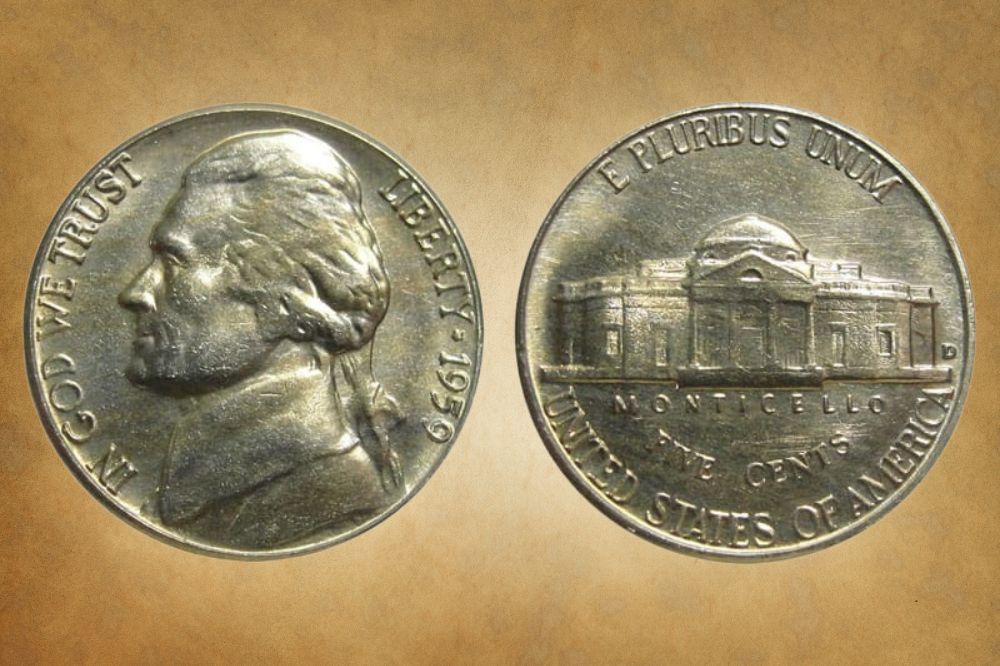
When you’re starting out in the coin-collecting business, you might get confused by the Founding Father portraits on the silver-toned ones. Particularly, Thomas Jefferson on the Nickel and George Washington on the Quarter. Here’s a hint – Jefferson has a shirt collar but Washington doesn’t! Jokes and fashion choices aside, let’s look at the 1959 Nickel Value.
1959 Nickel Value Chart |
|||
| Mint Mark | Good (G 4) | Mint State (MS 65) | Proof (PR / PF 65) |
| 1959 No Mint Mark Nickel Value | $0.28 | $11 | $3.30 |
| 1959-D Nickel Value | $0.28 | $9.13 | No D-Proofs |
1959 Nickel Value Guide
The coinage section of the San Francisco Mint was closed in 1955 and re-opened in 1968, so no nickels were minted there in 1959. Let’s review the nickels from the other two mints.
1959 no mint mark Nickel Value
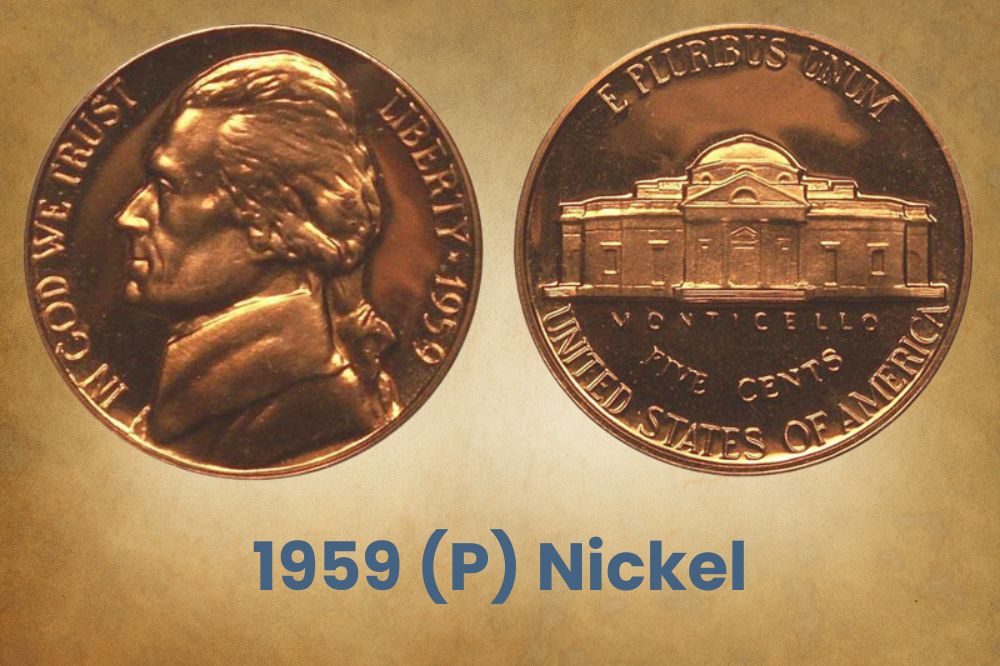
In 1959, the Philadelphia Mint made 28,397,291 Jefferson Nickels without mint marks. In MS 67 FS, this coin is worth $6,000. Back then, proof coins were still being minted in Philadelphia, and a PR 69 DCAM sold for $7,000. Proofs don’t always sell that well, but since it’s unclear how many proofs were minted in 1959, their rarity makes them expensive.
For reference, a business strike coin intended for circulation is minted the normal way. But a proof coin is minted on pre-polished planchets using dies treated with special chemicals that facilitate a mirrored field and a frosted device. The coins with the biggest contrast between the field and the device are graded Deep Cameo or Ultra Cameo. The next grade is Cameo.
Usually, only the first 50 to 100 coins get the DCAM or U-CAM rating while the next hundred or so are cameos. Also, PR and Deep Cameo are PCGS grades (Professional Coin Grading Service) while PF and Ultra Cameo are the same grades, but by NGC (Numismatic Guaranty Corporation). To compare these samples, a PF 69 Ultra Cameo sold for $3,290.
1959-D Nickel Value
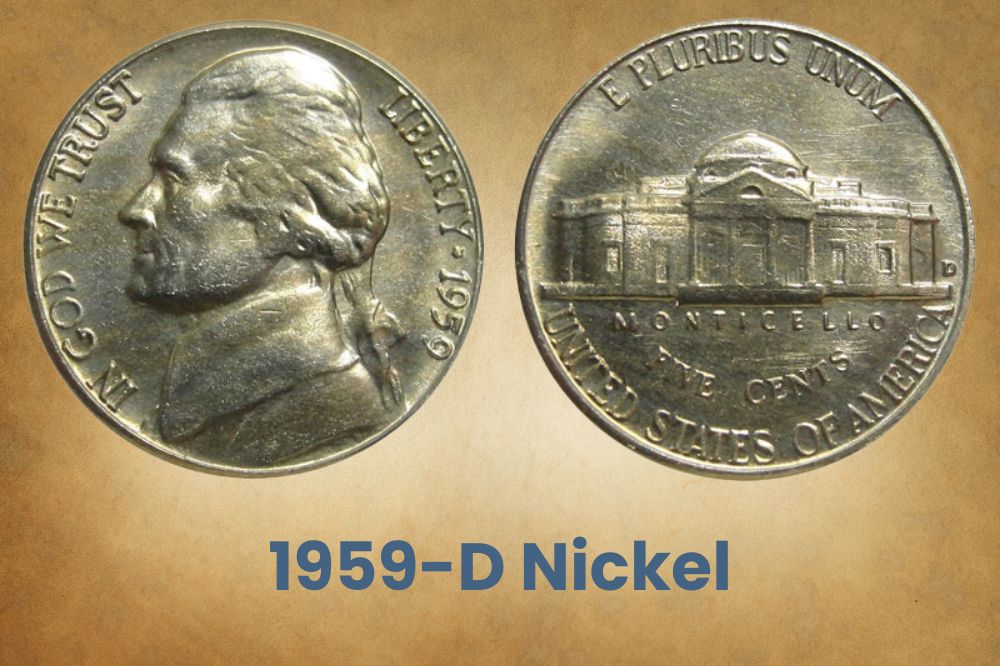
The Denver Mint produced 160,738,240 Jefferson Nickels in 1959. In MS 66 FS, this coin is worth around $1,600. However … the Denver Mint produced a lot of expensive error coins!
Related Posts: 17 Most Valuable Nickel Errors
1959 Nickel Errors
The face value of a 1959 Nickel is only 5 cents, and its melt value is barely worth a quarter. But coin errors can make a nickel resell for way more than that, so let’s look at the valuable ones.
1959-D Nickel Obverse Die Cud Error
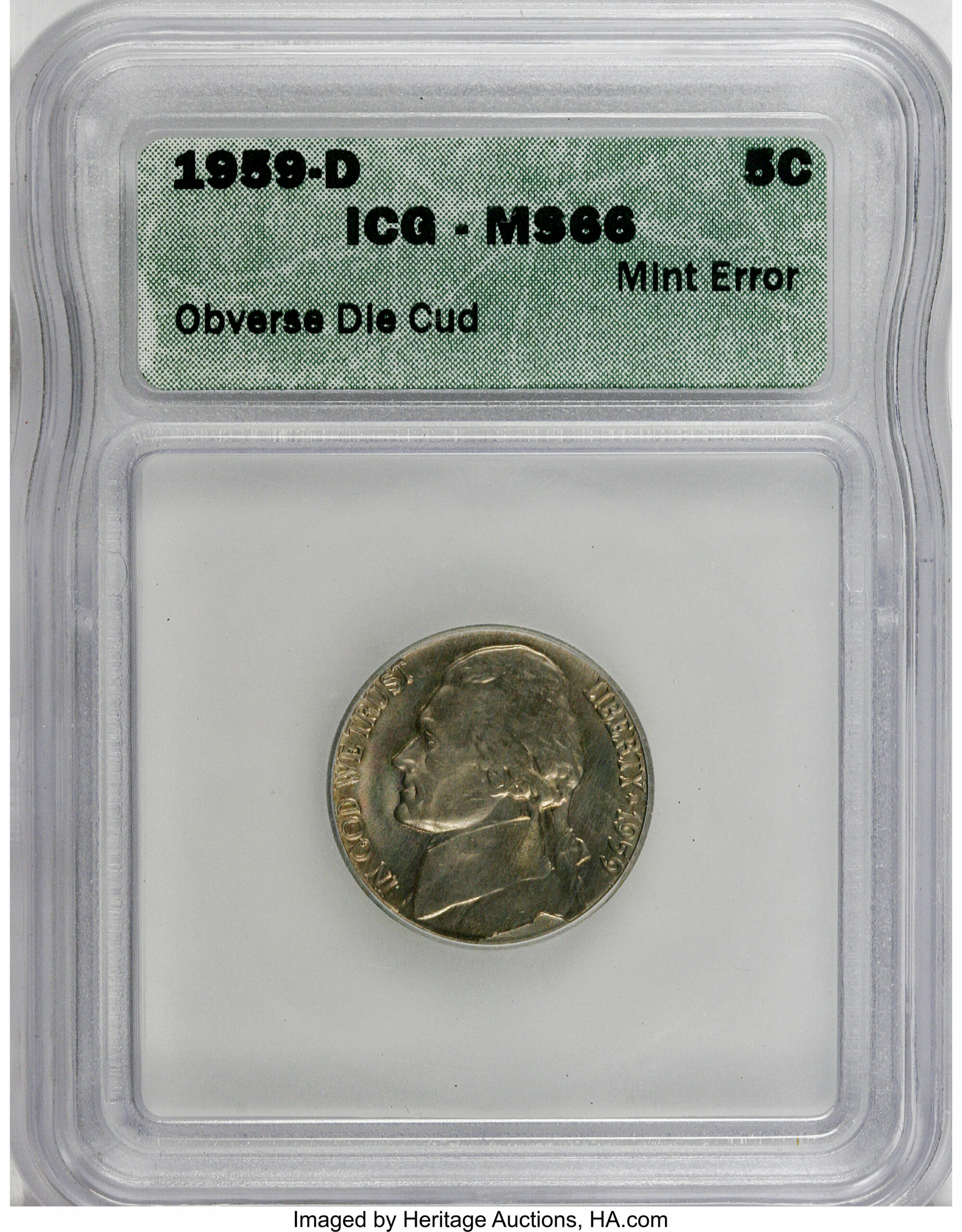
Cud errors are caused by die breaks that happen as dies get older. These steel ‘coin stamps’ are quite expensive so the mint uses them as long as possible. And towards the end of their viability, they develop cracks and gashes that transfer onto the coin. Cud errors or die breaks often appear as smudges, cracks, or chips on the coin surface. In MS 66, they’re worth $15.
1959-D Nickel Double Struck Error
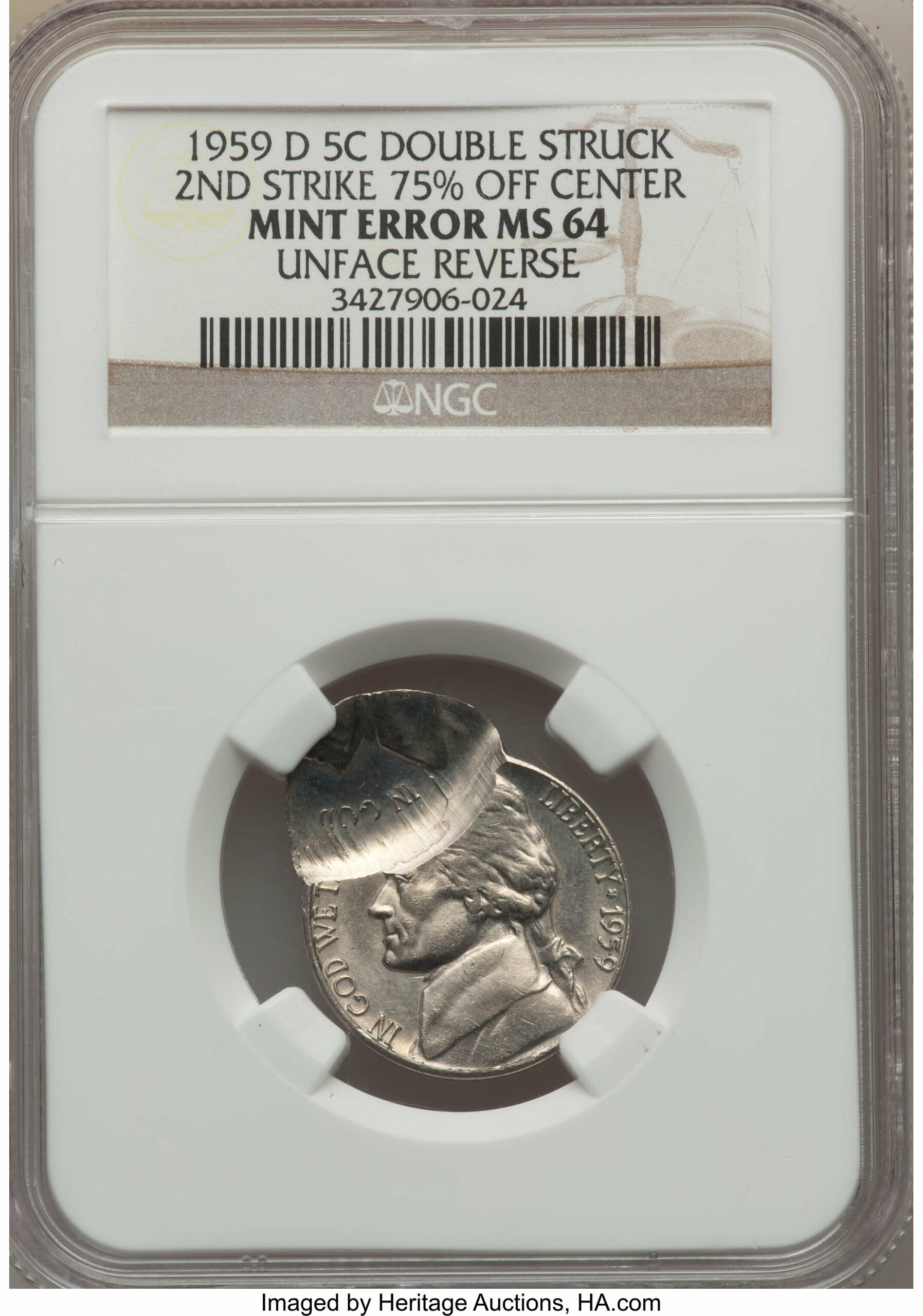
In the coin world, the fewer strikes it takes to secure a coin’s design, the better (and cheaper) it is for the mint. But most coins still need at least two strikes to facilitate fidelity, and the planchet, die, or hub might move between strikes. On this coin, the planchet partially exited the feeder belt between strikes, deforming the shape of the coin. In MS 62, it’s worth $125.
1959-D Nickel Struck on a Silver 10c Planchet
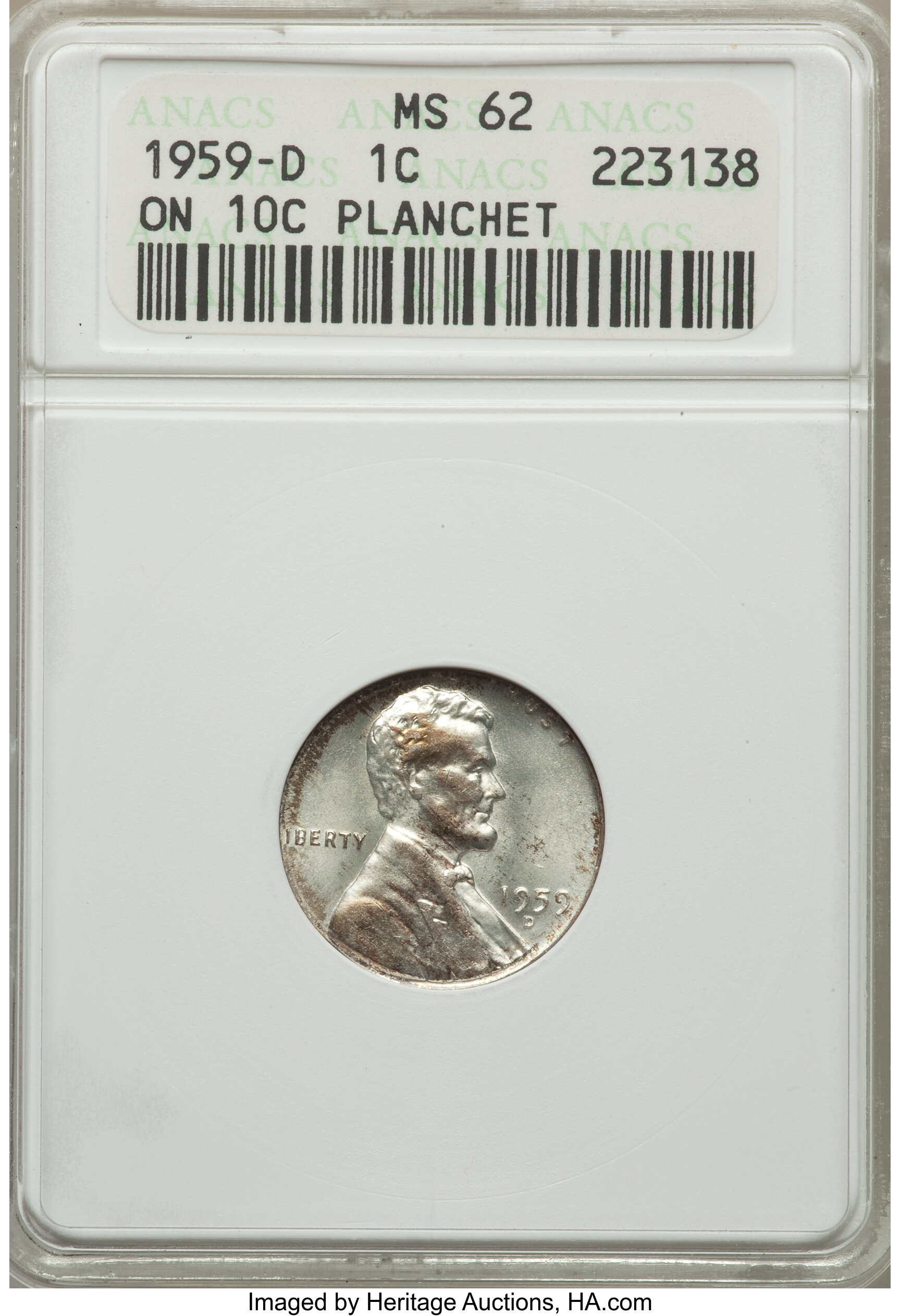
In 1959, dimes were still 90% silver. But at 17.91mm in diameter and 1.35mm thick, they were visibly smaller and slimmer than nickels. So a 5c struck on a 10c planchet would have part of its legends chopped off and would be considerably lighter. That’s why it’s important to weigh your coins as soon as you find them. In AU 58, this coin sold for more than $630.
1959 Nickel Struck on a Penny Planchet
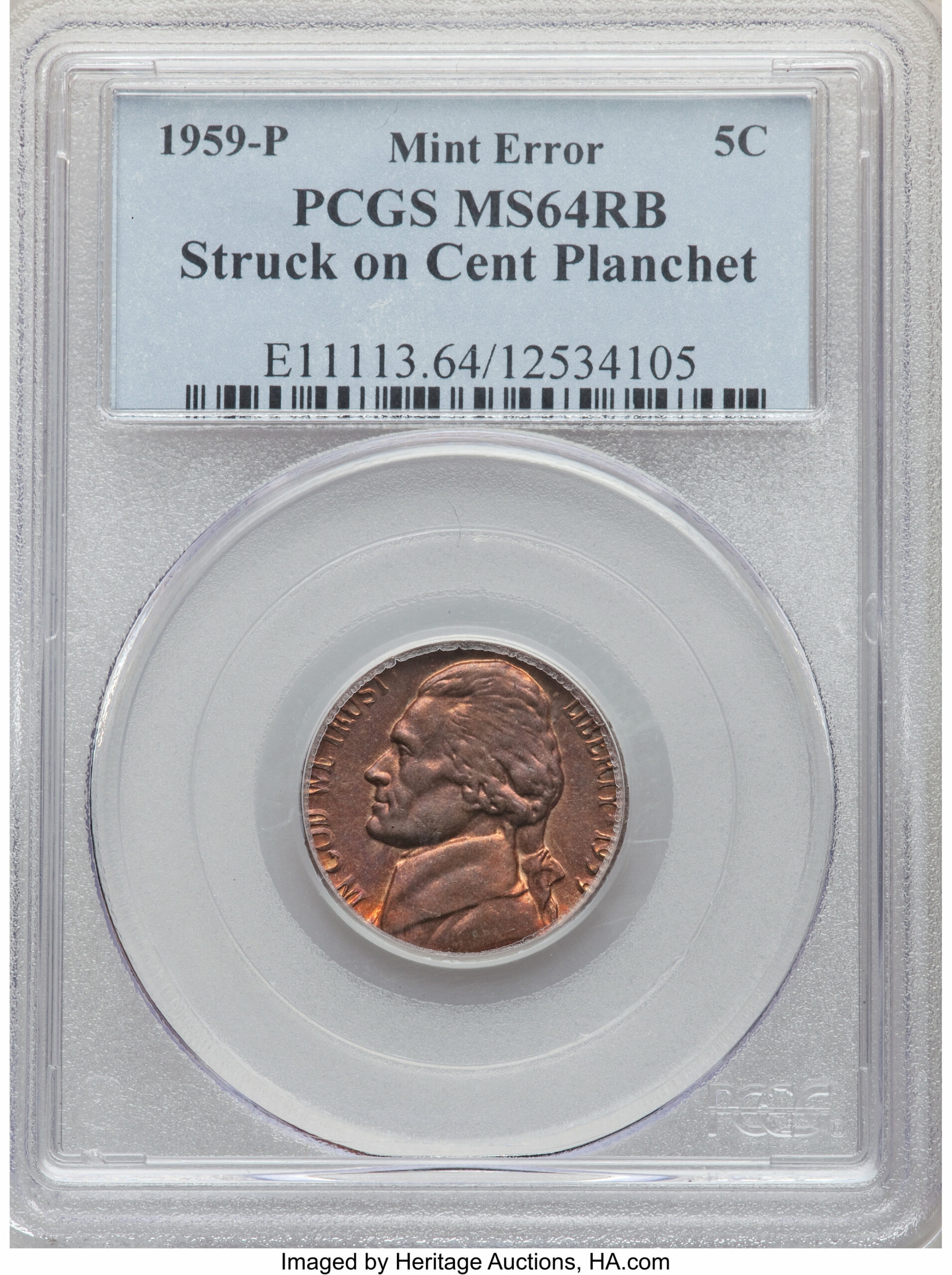
At 19.05mm, Lincoln Cents are closer in size to Jefferson Nickels. But penny planchets have that distinct coppery tone so you can effortlessly spot this planchet error. And being a 1-cent planchet, it’ll be color graded from red (RD) for the best to brown (BN) for the worst. So this wrong planchet error in MS 64 RD raises the value of this nickel from 5c to over $1,000!
1959-D Nickel Staple Struck Into Reverse
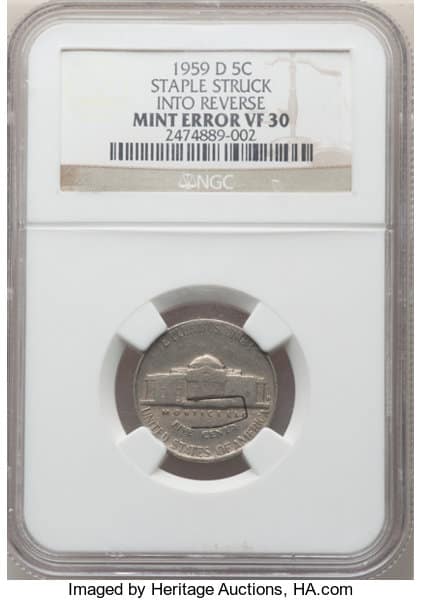
At the mint, planchets are struck with obverse and reverse dies to imprint the coin’s design onto the metal. But sometimes, a foreign object might sneak between the planchet and the die. This can cause a silhouette or stencil of the object to be accidentally engraved onto the coin. Here, a staple slipped onto the reverse, and in VF 30, it’s worth approximately $525.
1959-D Nickel Staple Struck Into Obverse
It would seem a lot of staples were floating around the Denver Mint in 1959. Here’s another example of a staple error, but this time on the obverse. And on both these coins, the staple didn’t just leave a shadow on the coin – it bonded onto the coin itself and is still jammed in place. This makes the coin more expensive than a mere strikethrough. In MS 64, it’s $545.
1959-D Nickel Struck Thru Struck Fragments
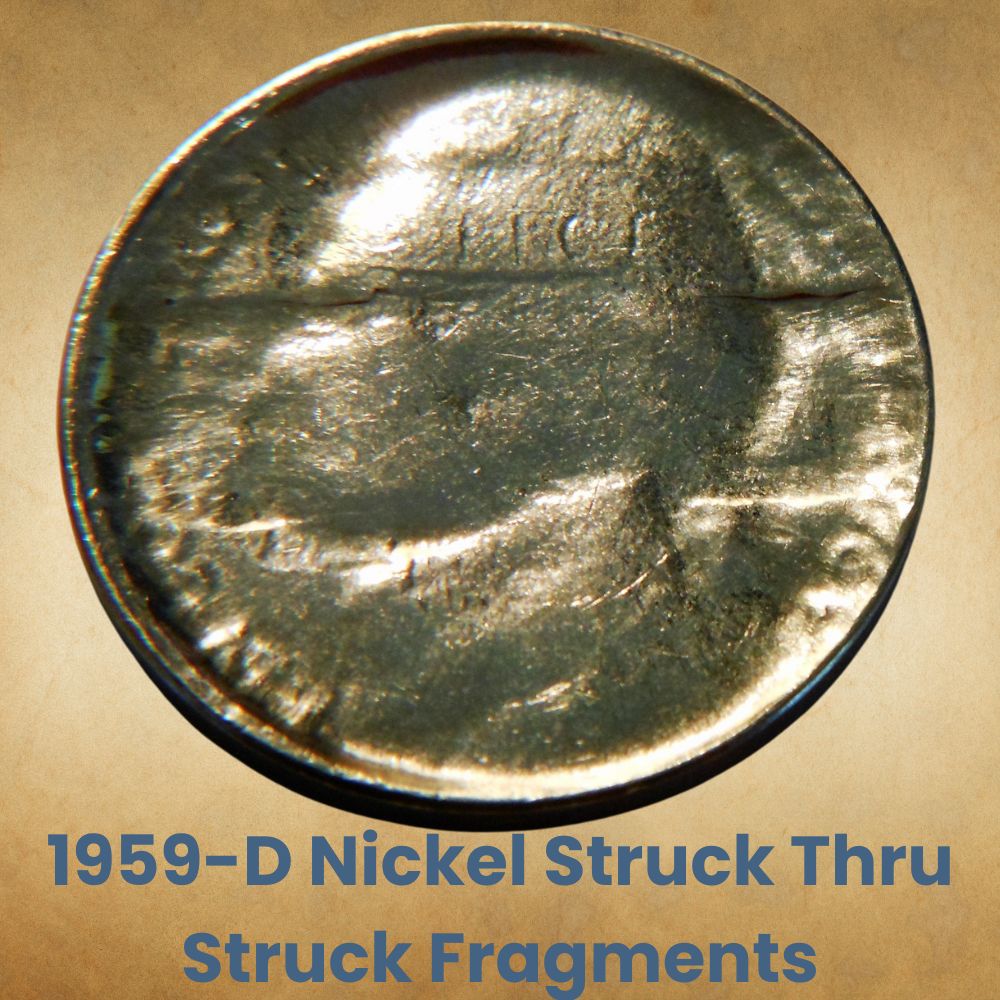
We’ve just mentioned a strikethrough or struck thru error. That’s when a foreign object slips between the die and the planchet, but it falls off before the coin leaves the mint. In that case, you’ll see an indent or impression on the coin that matches the interference. On this coin, the fragments look like a barrette in Jefferson’s hair. In MS 65, this coin error can sell for $70.
1959 Nickel Black Beauty Error
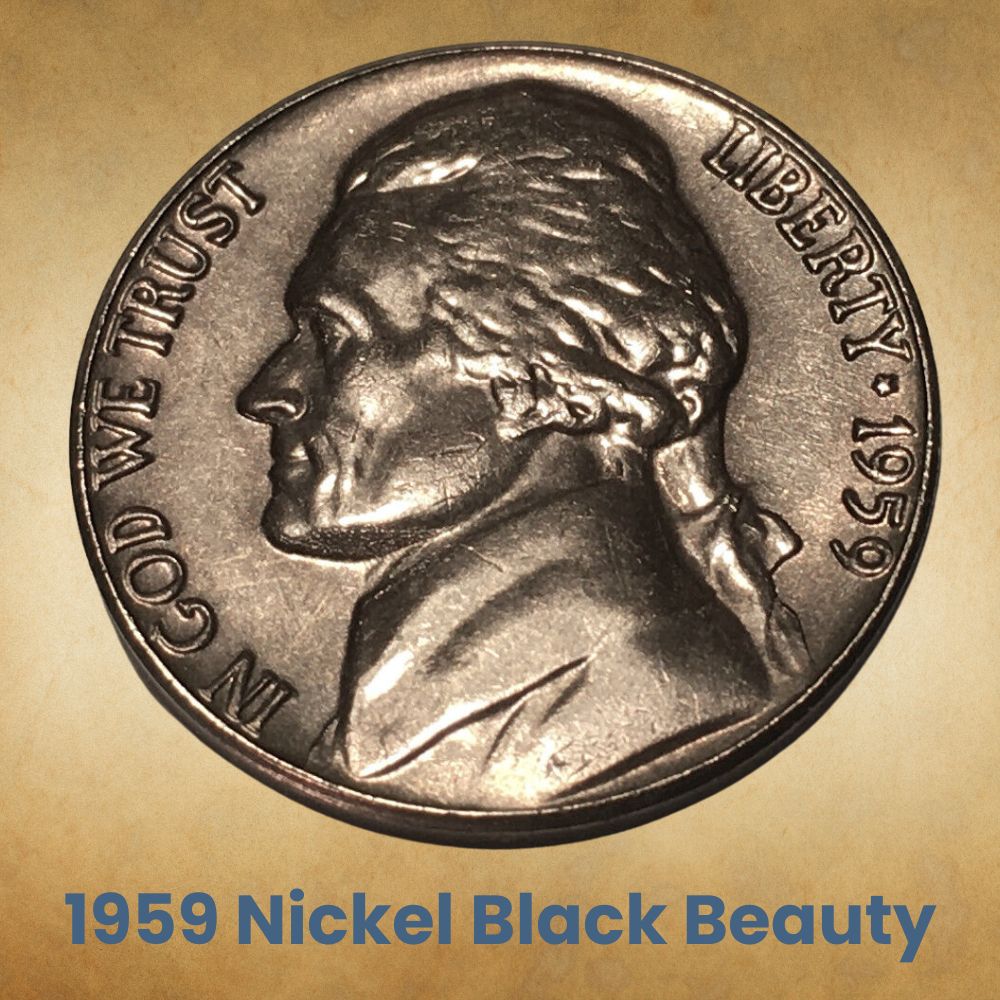
The three best-known coin evaluation companies are NGC, PCGS, and ANACS (The American Numismatic Association Certification Service). And in 2010, they discovered a 1959 Nickel error that they branded Black Beauty. It’s caused by improper annealing when the planchet is heated too long before coining. It’s a pretty flaw, but not especially valuable.
Related Posts: 19 Most Valuable Nickel Worth Money
History of the 1959 Nickel
What’s the difference between a nickel and a half dime? Well, half dimes were silver and were used from 1793 to 1873. Then, due to the public hoarding silver coins, the US Mint introduced clad 5-cent coins in 1866. These coins were 75% copper and 25% nickel, so they were nicknamed nickels. For reference, half dimes were among the earliest American coins.
Before independence, we used colonial coins, and later Spanish Silver Dollars from Mexico. They were called 8-Reales or Pieces of 8 and had octagonal edges that could be physically cut into 8 pieces called bits. When we started making American coins, we used the same system, so we implemented a popular Two Bit piece called a Quarter that was worth 25 cents.
In smaller denominations, we had a one-cent or copper penny, but the two-cent, three-cent, and five-cent were silver. The 5-cent was called a half disme, though the ‘s’ was silent, and was later taken out. But during the Civil War, people started hoarding gold and silver coins to melt them down for bullion. So the mint introduced clad metals for the 2-cent and 3-cent.
Once the public accepted these cupronickel coins, the 5-cent joined the bandwagon in 1866. The penny stayed copper until 1965 when all American coinage except the half dollar were converted to clad compositions. This was the result of rising silver prices that caused a coin shortage when once again, citizens started hoarding silver coins and melting them down.
This practice is called silver stacking, and it’s a popular way for regular folk to accumulate bullion, but it costs the mint a lot of money because they have to keep making new coins. Back to nickels. They included the Shield Nickel (1866 to 1883), V-Nickel or Liberty Head Nickel (1883 to 1913), Buffalo Nickel (1913 to 1938), and the Jefferson Nickel (1938 to date).
All About the Jefferson Nickel
All these coins were 75% copper and 25% nickel except during the War Years (1942 to 1945) when they were 56% copper, 35% silver, and 9% manganese. These coins were changed so that nickel could be redirected to the war effort where it was needed for military equipment and weapons. You could spot these War Nickels at a glance since they had a huge mint mark.
Wartime Nickels were the only coins to bear a P Mint Mark before 1979. Before then, coins from the Philadelphia Mint didn’t have one. And the reason these Silver Nickels were loudly marked was to make it easier to take them out of circulation after the war. Notably, they were Jefferson Nickels, and the 1959 was a Jefferson too. The coins were designed by Felix Schlag.
He won a contest to redesign the Buffalo Nickel after it hit its 25-year mark, but his initials were left off the coin until 1966, which means the 1959 Nickel doesn’t have his signature on it. But his design was so popular that the obverse was used until 2003 and the reverse was used until 2004. The obverse was eventually changed, but the reverse resumed after 2006.
The reason they settled on Jefferson was that his bicentennial was coming up in 1943. So the contest rules demanded a Thomas Jefferson obverse and a Monticello reverse. Schlag’s first sketch showed Monticello at an angle, but he was asked to change it to a full frontal image. For reference, Monticello is Jefferson’s mansion and plantation in Charlottesville, Virginia.
Schlag’s obverse was based on the Presidential Bust sculpted by Jean-Antoine Houdon in 1789. He was paid $1,000 for his winning coin design. His coin was awarded in April and he soon moved on to other projects. So when the mint requested changes, he didn’t get round to making them until mid-June! The approved nickels were finally released in November 1938.
Related Posts: 20 Most Valuable Buffalo Nickels Worth Money
How to Identify 1959 Nickel?
Let’s start by looking at a few key coinage terms. Coins are minted on blank metal sheets that are punched into discs called planchets. The heads side is called the obverse and the tails side is called the reverse. The words are legends or mottos. The image is called a device and the background is referred to as the field. Now let’s explore the 1959 Nickel’s characteristics.
The Obverse of the 1959 Nickel
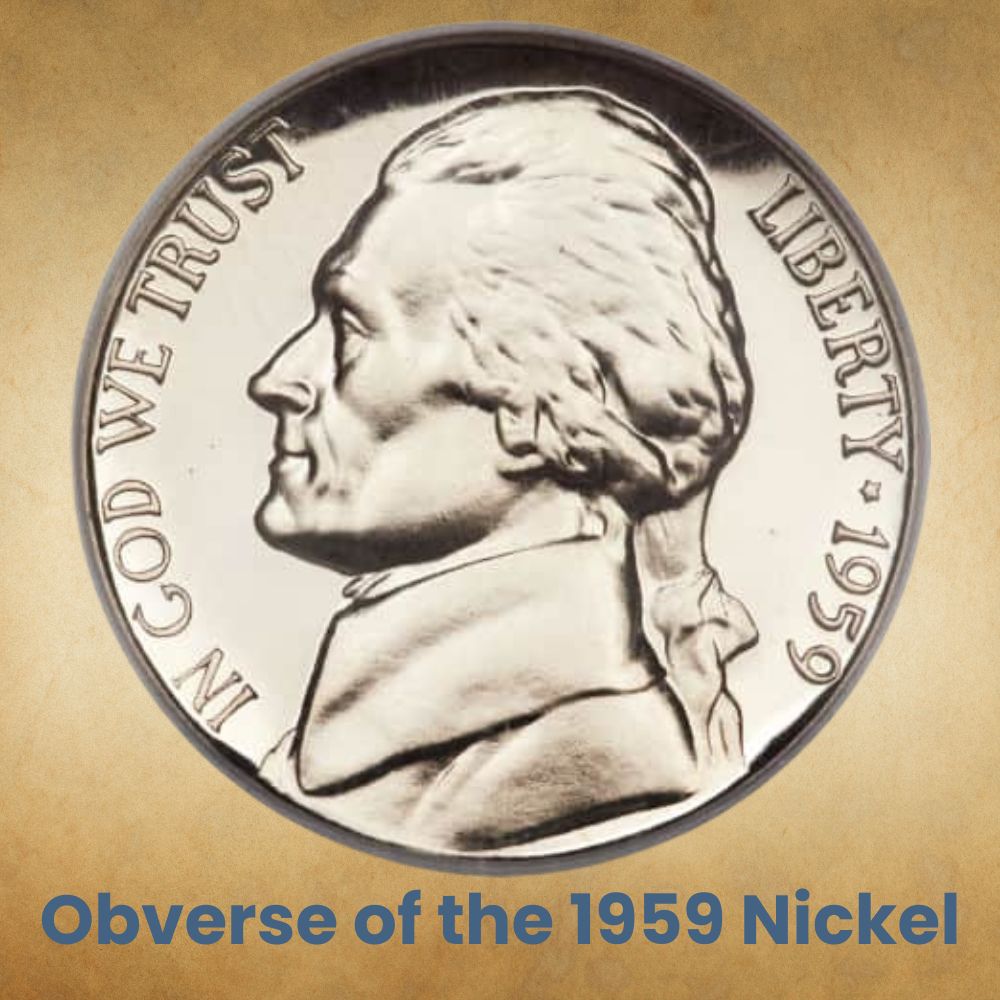
The obverse (heads side) of the 1959 Nickel features a portrait of Thomas Jefferson facing left. In God We Trust runs along the left rim, in front of his face, while Liberty runs along the right rim, behind his head. After Liberty, there’s a star, followed by the mint date. On coins minted after 1966, there’s FS on the shoulder cut-off, but the 1959 Nickel doesn’t have this.
The Reverse of the 1959 Nickel
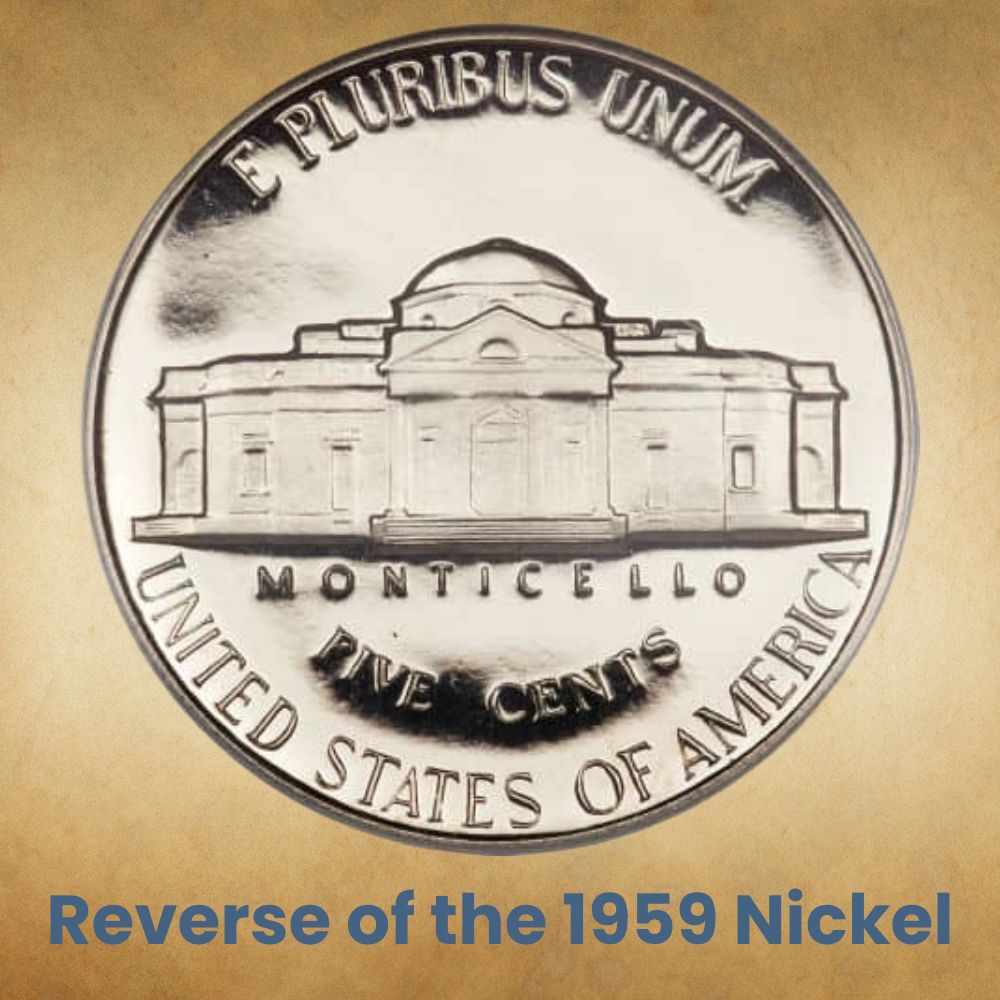
The reverse (tails side) of the 1959 Nickel features a forward-facing sculpture of Monticello. For coins after 2006, you can see FS at the right corner of Monticello. But on older coins, including the 1959 Nickel, that spot contains the mint mark. The top rim of the coin bears the motto E Pluribus Unum and the bottom collar has the legend United States of America.
The Monticello building fills the center of the coin, with the word Monticello beneath the steps. Under that is the denomination, Five Cents. Jefferson Nickels are typically graded according to the clarity of the steps and how easily you can count them. The best grades are 5S and 6S, meaning you can distinctly see five to six of the steps at the building entrance.
Other Features of the 1959 Nickel
The 1959 Nickel – like all others except War Nickels – was 75% copper and 25% nickel. It’s 21.21mm in diameter, 1.95mm thick, and weighs 5g. Its edges are smooth and have no reeds. Schlag’s winning design was one of 390 contest entries judged over a period of four days, but as we said earlier, he had to redo the reverse after he won. His initial reverse included a tree.
On most US coins, United States of America runs along the top, not the bottom. But Schlag was a German immigrant who had only been around for 9 years and may not have known this. While editing Monticello, he was asked to change the position of the legend, but it somehow slipped past and was approved as it was – his edits had already taken 3 months!
FAQs About the 1959 Nickel
Are 1959 Nickels Rare?
Not really. Almost 190M were coined at both mints, so you can still find them in circulation.
Does a 1959 Nickel Have Silver?
No. The only nickels that contain silver are the Wartime Nickels coined from 1942 to 1945. You can spot them because they have a massive mint mark above the dome of Monticello.

I am almost certain I found a 1959 D/S Jefferson Nickel. And I do know San Francisco stopped minting in 1955. If there was a way to send you a picture here of a magnified close up, I would. I did check with a local coin shop who agreed with me as well.
There is no listing to my knowledge of any such nickel being struck. Advice?